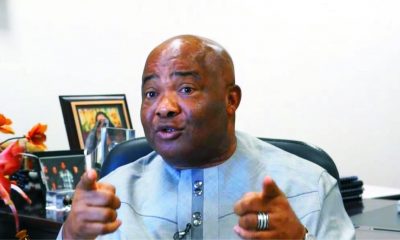Column
Information Minister And Journalists’ Pay Rise
Information and Communications Minister, Labaran Maku recently rekindled the hope of journalists working with government-owned media organisations that their future is still bright. Indeed, he re-assured media workers that moves were still in the offing to review upward their salary structure in order to beef up their monthly take home pay.
Addressing the national leadership of the Nigeria Union of Journalists (NUJ) who called on him in his office in Abuja, Maku asked the NUJ not to lose sleep on the issue of a better pay package, as obtains in advanced countries and other developing nations.
Besides, Maku, while addressing the leadership of RATTAWU (Radio, Television and Theatre Workers Union), who visited him in his office, not too long ago, also assured the union that everything humanly possible was being done to bring to reality the proposed pay rise for media workers. However, the minister did not say exactly when government will make good its promise (which has lingered on for years) that it would review upward the salary of newsmen in government establishments.
One can recall that over the years, the issue of having a special salary structure for journalists in public service has been a subject of public discourse. Indeed, newsmen working tirelessly with government-owned media organizations have literally (in the past years), wailed to the authorities to place them outside the current remunerative system of federal and state governments, and make the journalism profession more attractive in public organizations.
Sadly, their cries had, as it were, fell on deaf ears. How? Successive regimes in the country (for inexplicable reasons) failed to pull “government journalists” from the shackles of the current civil service salary structure.
Yes, it is an incontrovertible fact that the Nigeria Union of Journalists (NUJ), the umbrella body of journalists, has for many years, been insisting that its members, working with government-owned media, should be placed on a special salary structure to make them have a sense of belonging. But the effort of the union did not pay off as successive administrations continued to treat the matter with levity.
Perhaps, touched by the cries of newsmen, specially the NUJ, Prof. Dora Akunyili, the immediate past Information and Communications Minister, last year, set up a committee to draw up a special salary structure for media men, working with government –owned organizations.
Receiving the report of the committee while she was in office, Prof. Akunyili said time has come in this country for journalists in government media to have a special salary scale, such as nurses, teachers, lawyers, doctors, among others. She noted that the absence of a special salary structure was affecting the psychic of government newsmen.
The minister, thanking the committee for a job well done, assured journalists that the report would be critically studied for onward submission to the appropriate authorities for implementation.
To effectively consolidate the gains in the information sector in the country, it behoves the appropriate authorities to have ensured the immediate implementation of the Prof. Akunyili’s proposed media workers’ salary structure in the country.
One believes fervently that it is high time that government at various levels recognize the immense contributions of journalists to national development; moreso, as they are seen and recognized as the ‘fourth estate of the realm’.
That is why everything must be done to make government employed journalists happy and comfortable to enable them, as “watchdogs of the society”, have a sense of belonging and spur the nation’s desired development through sound information dissemination system.
Happily, the current leadership of the Federal Ministry of Information and Communications has played its part by working out a special media workers salary structure ostensibly to boost the morale of journalists, working with government-owned media.
But, the ministry’s approval of a new salary package for newsmen does not really count. The workability of the approval lies in the implementation of the new salary structure by the federal and state governments.
This is why both the authorities of the ministry and the NUJ must prevail on the various governments in the federation to ensure the approval and implementation of the proposed media workers salary structure. That way, the effort of the ministry in working out an acceptable salary structure for journalists would not be an effort in futility.
Agreed, journalists are not the only group in the civil service to be given such preferential treatment. But given the kind of jobs they do, as ‘Agenda Setters, Voice of the Voiceless and Conscience of the Society,” they (journalists) need to be encouraged (through good salary package) so that their mental and physical well-being will be in proper shape at all times.
Well, it is necessary at this juncture to point out that this is certainly not the first time efforts have been made to pull journalists from the civil service remunerative system. Indeed, past administrations in conjunction with the NUJ, made some palpable moves in this regard, but their efforts did not pay off, as recommendations for new pay rise for journalists were not implemented by the authorities concerned.
Therefore, the federal information ministry, especially the committee that worked assiduously to map out the proposed pay rise, must ensure that it appeals to the conscience of all relevant government agencies so that the implementation of the new salary structure would not be halted by the various governments at all levels.
It is public knowledge that the brain-drain being experienced in government-owned media organizations, is as a result of poor take-home pay in the journalism profession. Sadly, the best brains in journalism profession are already drifting to private media organizations to seek for greener pastures. This is unfortunate, to say the least!
It stands to reason, therefore, that to retain the best brains in government media establishments, the ministry’s recommendation on journalists’ special salary structure must be given the attention it deserves.
But, can the Information Minister ensures the implementation of the proposed special salary scale before he leaves office? This is the mind-boggling question, now being asked by media men, given the short period left for the minister.
Column
Are the Bears Wrong About the Looming Glut in Oil?

Column
Renewable Energy Faces Looming Workforce Crisis

Column
Is It End For Lithium’s Reign As Battery King?

-

 Oil & Energy2 days ago
Oil & Energy2 days agoHysteria Clashes with Missing Oil Barrels
-
Rivers2 days ago
Shippers Council moves To Enhance Service Delivery At Nigerian Ports
-

 Business5 days ago
Business5 days agoNigeria’s Gold, Other Solid Minerals Being Stolen – NEC
-

 Editorial2 days ago
Editorial2 days agoStrike: Heeding ASUU’s Demands
-

 Oil & Energy2 days ago
Oil & Energy2 days agoOil Theft: Economic Council Urges NNPC To Strengthen Security In Creeks
-

 News2 days ago
News2 days agoAir Peace Begins Direct Flight From Abuja To London
-

 Business2 days ago
Business2 days agoNigeria Exits FATF Grey List For Global Financial Crime ………..NFIU
-

 Nation2 days ago
Nation2 days agoCommunity Health Practitioners Marks 2025 Week

